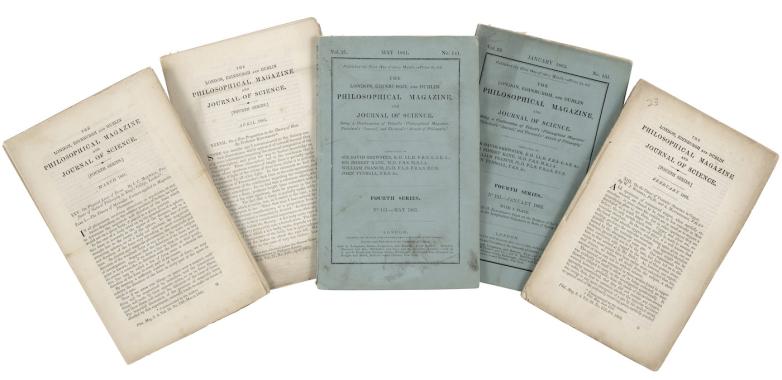Bonhams Auction Showcases Scientific Cosmology

James Clerk Maxwell's landmark 1861-1862 paper On the Physical Lines of Force. Estimate: $20,000-30,000
New York — Bonhams' 10 Exceptional Works of Science sale, available online from July 20 - 27, will celebrate major figures and breakthroughs within the history of science. Tracing an arc of discovery beginning in the 16th century with a book from the library of Rheticus to Stephen Hawking's most important work, which altered our very conception of the construction of black holes, the sale gives incredible insight into the field of cosmology.
A SCIENTIFIC BOOK FROM THE LIBRARY OF RHETICUS
Estimate: $100,000–150,000
Interestingly, Copernicus was not the first person to propose the heliocentric system in print. That honor belongs to Joachim Georg Rhaeticus, called Rheticus, who published his Narratio Prima, announcing the Copernican system in 1540. The herald of the revolution, Rheticus had met Copernicus in 1539 and quickly understood the genius and sense of the revolutionary new model. However, the idea that the earth revolved around the sun was unsettling to a world that for centuries had given the earth central place in the solar system and tied its notions of religion to that model. It was Rheticus who first announced Copernicus’s theories, then oversaw and arranged the full publication of those theories in Copernicus’s 1543 De Revolutionibus, which forever altered the way we view the world. We are offering here a scientific book from Rheticus’ library, his copy of a 1561 edition of Proclus’s De Sphaera.
NEWTON'S PRINCIPIA IN ENGLISH
Estimate: $50,000–70,000
Johannes Kepler would further define the Copernican system in the early 17th century, giving a scientific framework for the movement of the planets around the sun, but it was Isaac Newton’s Principia Mathematica in 1687 which provided the physical mechanism for that movement with his discovery of the law of universal gravitation. Newton’s monumental discovery set forth the basic mechanics of our physical universe and created a universal framework for scientists to explore our universe. This first edition in English of Newton’s Principia would have a profound effect on the scientific community in the western world.
MAXWELL BUILDS THE BRIDGE TO THE 20TH CENTURY AND BEYOND
Estimate: $20,000–30,000
Newton’s laws governed scientific understanding for two centuries, and in many senses still do today, but in the mid-nineteenth century scientists such as James Clerk Maxwell and Michael Faraday began to fully understand and measure the physical forces that supported Newton’s conception of gravity. Maxwell’s announcement of his equations allowing us to understand electromagnetic radiation and the relation of those forces to the speed of light would pave the way for the next generation of physicists. As revolutionary in their way as Newton’s gravity, Maxwell’s conception of field theory forms the basis for our modern understanding of the universe. His landmark 1861-1862 paper On the Physical Lines of Force, offered here, announced the equations that would come to govern our fundamental conception of our world.
POINCARÉ'S LAST WORD ON RELATIVITY
Estimate: $30,000–50,000
Most people know Albert Einstein as the creator of the theory of relativity. However, two other scientists in the late 19th and early 20th century made enormous contributions in the field of relativity: Hendrik Lorentz and Henri Poincaré. Poincaré first posited the relation of mass and energy in the form "mr = E/c2" in 1900, and his 1904 paper first pointed to the existence of gravitational waves. We are offering here the exceptional, original autograph manuscript for Poincaré's last paper on relativity, “L’espace et le Temps,” containing his final views on the topic.
EINSTEIN AND THE CREATION OF MODERN COSMOLOGY
Estimate: $15,000–25,000
Following his complete formulation of the laws of general relativity in 1915, Einstein began to apply those laws to the universe more broadly. In 1917, he published "Cosmological Considerations of the General Theory of Relativity" which contained the cosmological conception that would lead to the discovery of the expanding universe and ultimately the big bang theory. Offered here is the original 1917 offprint of his groundbreaking paper that would mark the beginnings of our modern cosmological understanding of the 20th and 21st centuries.
HAWKING'S COPY OF HIS MOST IMPORTANT WORK
Estimate: $20,000–30,000
Einstein’s revolutionary theory of relativity led to a number of incredible consequences in our understanding of the universe, including the existence of Black Holes, first noted in 1915 by Karl Schwarzschild. Their existence was understood as a singularity whose gravity was so dense that nothing could escape from it, until 1974 when Stephen Hawking announced research indicating that in fact under quantum mechanics Black Holes could emit radiation (“Hawking Radiation”). Hawking’s paper creates stunning new possibilities in the study of gravity, space and time, and we are offering Hawking’s own copy from his library of this seminal paper, “Black Hole Explosions.”















